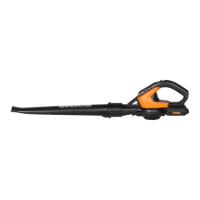5
2) Do not dispose of the battery(ies) in a fire. The cell
may explode. Check with local codes for possible
special disposal instructions.
3) Do not open or mutilate the battery(ies). Released
electrolyte is corrosive and may cause damage to
the eyes or skin. It may be toxic if swallowed.
4) Exercise care in handling batteries in order not
to short the battery with conducting materials
such as rings, bracelets, and keys. The battery or
conductor may overheat and cause burns.
3. Avoid unintentional starting – Do not insert the
battery with your finger on the switch. Be sure the
switch is off when inserting the battery.
SAVE THESE INSTRUCTIONS
ADDITIONAL SAFETY RULES FOR LAWN
TRIMMER AND EDGE TRIMMER
1. Keep guards in place and in good working order.
2. Keep hands and feet away from cutting area.
3. Do not use heavier lines than recommended in
this manual.
4. Do not use line materials of other types – for
example, metal wire, rope, and the like.
GENERAL SAFETY WARNINGS
WARNING: Read all safety warnings and
instructions. Failure to follow the warnings and
instructions may result in electric shock, fire
and/or serious injury.
1) WARNING: Risk of fire and burns. Do not
disassemble, heat above 100°C (212°F), or
incinerate. Do not expose cells or batteries
to heat or fire. Avoid storage in direct
sunlight.
2) Dispose of used battery promptly.. When
disposing of secondary cells or batteries,
keep cells or batteries of different
electrochemical systems separate from
each other.
3) Keep battery out of reach of children and in
original package until ready to use.
4) Never put batteries in mouth. If swallowed,
contact your physician or local poison
control center.
5) CAUTION – The battery used in this device
may present a risk of fire or chemical burn
if mistreated. Replace battery with ( WORX
) only. Use of another battery may present
a risk of fire or explosion
6) Warning: Do not use a visibly damaged
battery pack or appliance as applicable.
7) Warning: Do not modify or attempt to
repair the appliance or the battery pack as
applicable.
8) BATTERY MUST BE RECYCLED
9) Do not short-circuit a cell or battery. Do
not store cells or batteries haphazardly in
a box or drawer where they may short-
circuit each other or be short-circuited by
conductive materials.
10) Do not subject cells or batteries to
mechanical shock.
11) Keep cells and batteries clean and dry.
Wipe the cell or battery terminals with a clean
dry cloth if they become dirty.
12) Do not maintain secondary cells and
batteries on charge when not in use.
13) Retain the original cell and battery
literature for future reference.
14) Do not use any charger other than that
specifically provided for use with the
equipment. Secondary cells and batteries
need to be charged before use. Always use the
correct charger and refer to the manufacturer’s
instructions or equipment manual for proper
charging instructions.
15) When possible, remove the battery from the
equipment when not in use.
16) Prevent unintentional starting. Ensure the switch
is in the off-position before connecting to battery
pack, picking up or carrying the appliance.
Carrying the appliance with your finger on the
switch or energizing appliance that have the
switch on invites accidents.
17) Disconnect the battery pack from the appliance
before making any adjustments, changing
accessories, or storing appliance. Such
preventive safety measures reduce the risk of
starting the appliance accidentally.
18) Under abusive conditions, liquid may be ejected
from the battery; avoid contact. If contact
accidentally occurs, flush with water. If liquid
contacts eyes, additionally seek medical help.
Liquid ejected from the battery may cause
irritation or burns.
19) Have servicing performed by a qualified repair
person using only identical replacement parts.
This will ensure that the safety of the product is
maintained.
SAVE THESE INSTRUCTIONS

